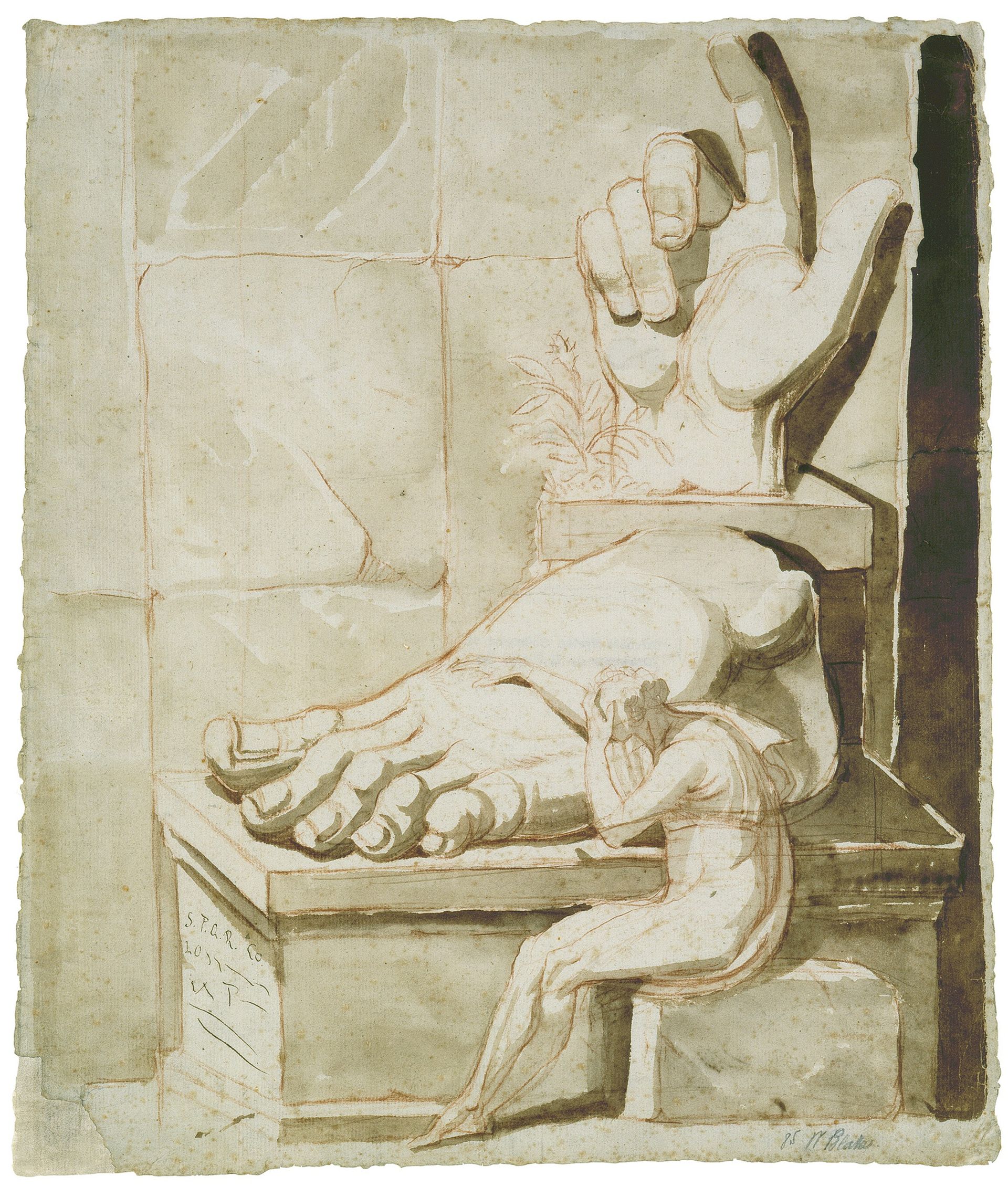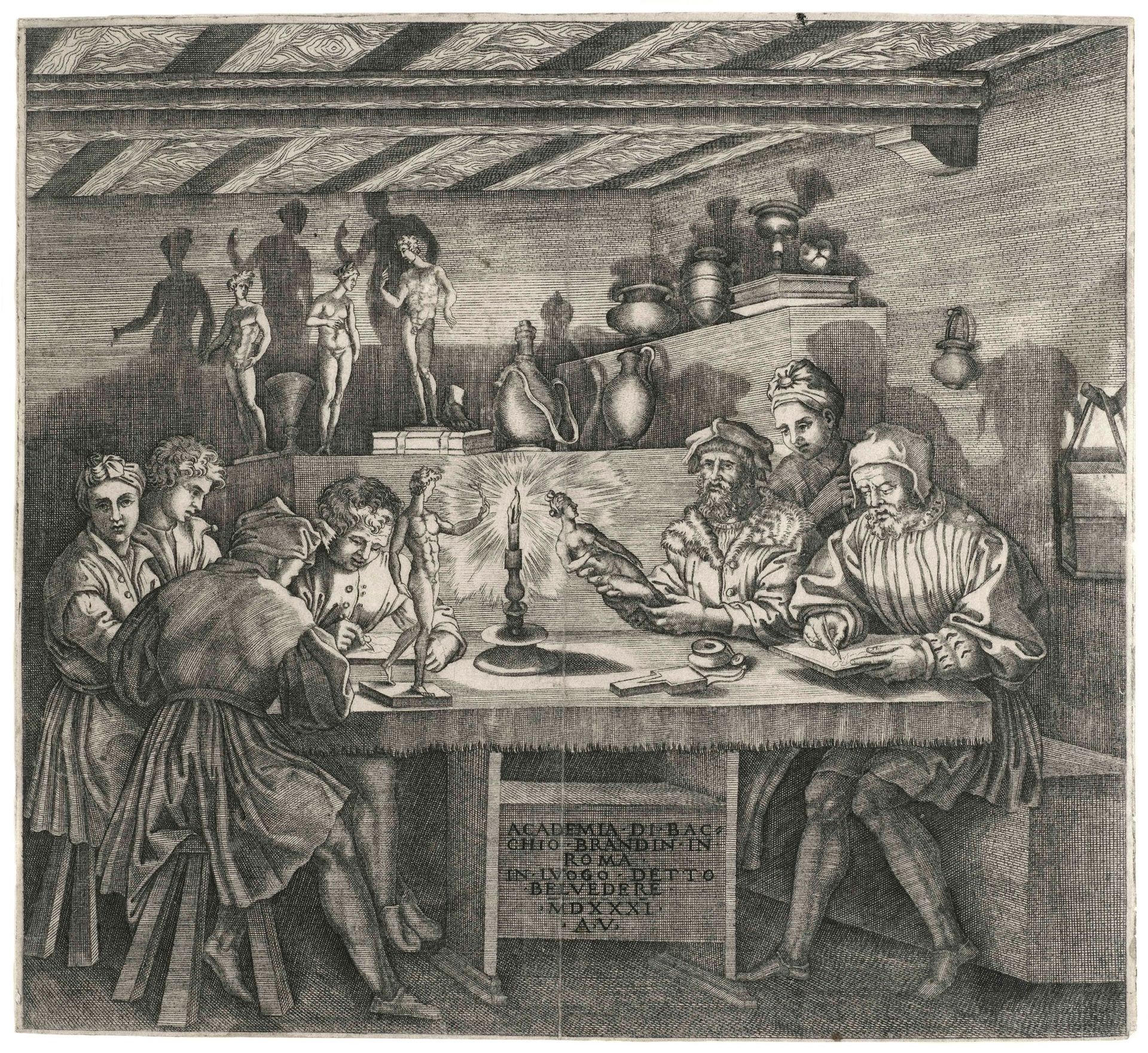The exhibition Drawn from the Antique is a collaboration between two extraordinary institutions: the Teylers Museum, Haarlem, and Sir John Soane’s Museum, London. Both of these remarkable cabinets of curiosities were created with a view to advance academic achievement and education. This exhibition is therefore particularly appropriate to the venues in question. The original inspiration for the show was the collection of drawings and prints featuring artists’ studios and academies belonging to the art dealer Katrin Bellinger, most of them relating directly to the study of antique statuary. Among the earliest works are seminal Renaissance images such as Agostino Veneziano’s Academy of Baccio Bandinelli in the Belvedere, Rome, of 1531, depicting artists copying statuettes of antique figures by candlelight. Later works from Bellinger’s collection that merit particular attention include a fine red chalk drawing by Hubert Robert of an artist seated at a table, copying with his porte-crayon a bust of the Roman Empress, Faustina the Younger, and Robert’s black chalk drawing of the Roman workshop of the celebrated sculptor and restorer of classical statuary, Bartolomeo Cavaceppi, which was in the eighteenth-century a must-see for any self-respecting Grand Tourist, and a training ground for young sculptors such as Joseph Nollekens.

The show is now at the Soane Museum—it was first at the Teylers—and although many of the exhibits are included in both venues, some are exclusive to one museum. Thus at the Teylers, the print by Cornelis Cort after Jan van der Straet’s The Practice of the Visual Arts (1578) from the Rijksmuseum, Amsterdam, was displayed, while the Soane has van der Straet’s original drawing from the collection of the British Museum; the selection dictated presumably by curatorial logistics. Similarly, Golzius’s chalk drawing of the Apollo Belvedere (1591) was displayed only at the Teylers while the engraving made from it—with the addition of the figure of a draughtsman at its feet—is shown only at the Soane. At the Teylers Museum the exhibition included a painting by the local artist Wybrand Hendriks of the Haarlem Drawing College of 1799, depicting its members grouped in conversation before an assembly of casts upon a mantelpiece and, hidden away in a corner of the room, the only female presence: a cast of the Venus de Medici.

For those seeing the exhibition at the Soane Museum in expanded form and spread across two galleries, there are welcome additions to the display from American, British and European collections. An impressive pen and ink drawing from the Getty Museum by Federico Zuccaro of his brother Taddeo at work in the Belevedere Court in the Vatican is the centrepiece of the first room. One in a series of 20 drawings made by Federico of Taddeo that charts his brother’s struggles as a young artist, this work also epitomises the exhibition’s central premise of how artists over the centuries were drawn to the antique as the bedrock of their artistic education. Other magnificent exhibits featured at the Soane include Charles Joseph Natoire’s meticulous watercolour of the life class at the Academie royal de peinture et de sculpture in Paris, bequeathed by Sir Robert Witt to the Courtauld Institute of Art, and one of the highlights of its drawings collection. Finally, one drawing that must be mentioned is Henry Fuseli’s extraordinary proto-romantic image, The Artist Moved by the Grandeur of Antique Fragments; the Right Hand and Left Foot of the Colossus of Constantine (c.1778-79), a composition which signals a sea change in artistic response to the antique, where admiration is tempered by despair and a sense of loss.

This powerful exhibition, spearheaded by Adriano Aymonino and Anne Varick Lauder, is supported by a catalogue packed with muscular scholarship. Aymonino’s extensive introductory essay on the theory and practice of drawing after the antique is a model of erudition and includes reference points and copious illustration that take us far beyond the immediate parameters of the show. In a similar fashion the scrupulous catalogue entries provide detailed information, interpretation and context. I would urge you to make an effort to see this exhibition and, even if you cannot get to the Soane, to acquire the publication, which is sure to become a benchmark in studies of artists and the antique.
Martin Postle is Deputy Director of Studies, the Paul Mellon Centre for Studies in British Art.
Drawn from the Antique: Artists and the Classical Ideal, Sir John Soane’s Museum, London, until 26 September

